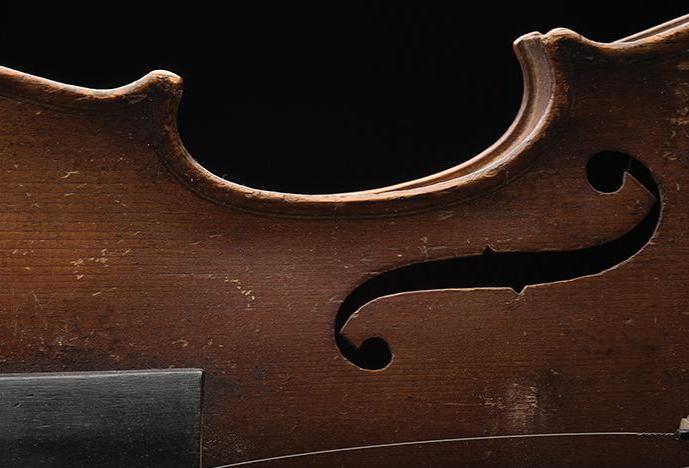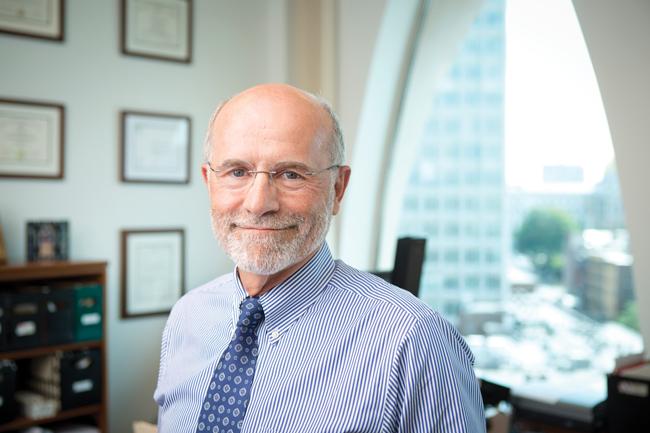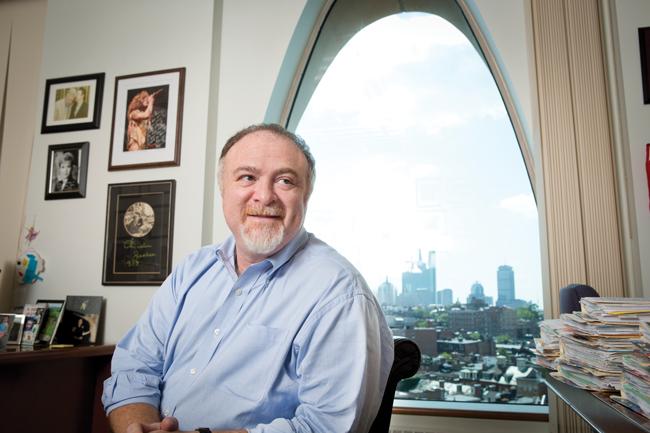Cord Changes
Laryngology is undergoing a high-tech, science-driven interdisciplinary remix
- 10 minute read
- Feature

Roger Egan remembers the precise date he was diagnosed with vocal cord cancer: March 8, 2012. The diagnostic biopsy, taken a few days earlier, had rendered him voiceless, so he had to sit silently as his diagnosis was delivered. But that was not the worst of it. A few days after Egan learned he had cancer, his father died. Again, Egan was mute; he had not yet regained his voice. “When my father needed me most, I couldn’t talk,” says Egan. “I understand the importance of having a voice.”
Egan’s voice is fine now, with the deep and resonant tone one might expect from a tall, sturdily built man. He was fortunate; he underwent an innovative type of laser surgery developed at HMS, a surgical option his doctors in North Carolina weren’t aware of. They had offered him radiation, the standard accepted therapy for this type of cancer. It would likely have cured the cancer, but it also would have brought pain and suffering—and the possibility of permanent voice loss.
“I was twenty-four hours away from going down a completely different path,” says Egan.
As with Egan, patients with voice problems now have more, and better, treatment options. Many of these advances, such as the angiolytic KTP laser used for Egan, have grown from the work of HMS researchers, especially those in the Center for Laryngeal Surgery and Voice Rehabilitation at Massachusetts General Hospital, more commonly known as the MGH Voice Center. Co-directed by Steven Zeitels, the Eugene B. Casey Professor of Laryngeal Surgery at HMS, and Robert Hillman, an HMS professor of surgery, the center has generated new ideas by bringing together the work of experts in disciplines from physics and cell biology to chemical engineering and mobile technologies. Laryngology is thus becoming a sophisticated, science-driven practice that is employing, and exploring, a range of technological options.
Background Vocals
Approximately 7.5 million people in the United States suffer from voice problems, according to the National Institutes of Health. This number will undoubtedly rise as the population ages. “People are living longer and working longer,” says Hillman, “and the aged voice can be weak and hard to understand.”
Overuse can also damage the surface and underlying tissues of the vocal cords, a pair of smooth membranes technically referred to as vocal folds, causing the voice to deteriorate. The types of damage such stress can produce include ruptured blood vessels and the development of hard calluses called nodules or soft growths called polyps. Even very young vocalists can experience damage trying to keep up with demanding vocal training schedules: Some collegiate programs require six hours of singing practice per day.
Surgeries using the green-light emitting angiolytic KTP (potassium, titanyl, phosphate) laser have been performed by Voice Center surgeons to repair overuse injuries in such famed singers as Adele, Steven Tyler, and Lionel Richie. All have been able to resume their performance schedules. Such results, however, are out of the ordinary. The standard treatments for overuse—blood-vessel cauterization or the surgical removal of growths—can result in scarring or stiffening of the vocal folds. Such changes can limit both the range and strength of a patient’s voice.
Disease also impairs voices. Viral respiratory papillomatosis, for instance, is characterized by the growth of warts on the surface of vocal folds. Smooth tissue becomes lumpy, forming cauliflower-like mounds. In severe cases, the mounds can ultimately block the larynx or trachea. For some patients, the disease recurs so quickly that managing it requires surgery many times a year; for a few, this can mean hundreds of surgeries over a lifetime.
Black Box

The larynx, more commonly referred to as the voice box, is one of the more mysterious parts of the body. It protects the airway to the lungs and houses the vocal folds, forming an obvious but elusive vocal instrument. Peering inside this box requires special equipment, says Hillman. “It’s very dark down there.”
To get a look, in 1807, European doctor Philipp Bozzini devised the first endoscope, called a light conductor, or in his native German, lichtleiter. The scope used an external candle to cast light on an internal mirror, thus illuminating the structure of a given cavity—such as the larynx, ear, urethra, or rectum—back to the eye. Throughout most of the nineteenth century, the laryngoscope was essentially a dental mirror. Contemporary laryngoscopes are illuminated speculae that allow a physician to see the vocal folds, which stretch from the front of the larynx to the back and are supported underneath by muscle and a jelly-like substance that keeps them pliable.
Healthy vocal folds vibrate, slamming together to create pulses of air that produce sound waves. In men, the vocal folds vibrate around 110 times per second; in women, 220 times per second, or between two and four times as fast as the beat of a ruby-throated hummingbird’s wings.
In the late 1800s, a primitive laryngostroboscope was developed, allowing laryngologists to visually capture the vocal folds in motion. The stroboscope creates an optical illusion that slows down the motion of the folds, similar to the way that strobe lights act to slow down the movements of dancers. Although modern computer-driven stroboscopes are still a mainstay of laryngology, HMS laryngologists have begun using high-speed digital video cameras to film the action. These cameras capture up to 10,000 images per second, enough to keep up with the fastest vibrating folds. About a decade ago, these videos revealed the detailed movements that determine whether a voice sounds normal or disordered.
Voices Carry
Perfecting ways to visualize the vocal folds and quantify voice production led Hillman to combine a career as a speech pathologist with voice science, the research side of laryngology. Today, Hillman can barely discuss his work without a visit to his research lab, the place where he evaluates patients’ voices and vocal anatomy before and after surgery or other treatments.
A focal point of Hillman’s lab is a sound-isolation booth filled with sensitive equipment capable of capturing the vibrations of vocal folds. The booth is designed to block building vibrations: twelve-inch-thick walls are deeply insulated while the room itself is suspended from rather than anchored to the building’s structure. In the booth, Hillman and his team use high-speed cameras to identify asymmetries as the vocal folds flap together. They also measure airflow and air pressures generated by the lungs during vocalization and use acoustic measures and other sensors to quantify patients’ vocal function.
Recently, Hillman and his team mobilized his recording technologies by creating an ambulatory monitoring system. Hillman uses the system to track patients as they speak in their daily lives to better understand how voice use and overuse contribute to common voice disorders.
The problem is that no one has yet quantified a healthy limit for voice use. So Hillman’s system monitors voice use automatically and tracks a patient continuously for up to a week. The system looks a bit like a police informant’s wire—the patient tapes a dime-sized disk to the base of the neck, below the larynx. The disk is wired to a smartphone carried in a pocket or worn on the hip, but instead of recording sounds, the disk picks up vibrations in the larynx before they’ve been shaped by the mouth.
Hillman has found that voice use, while a factor in some voice disorders, isn’t the only factor. For the past three years, his team has been using monitoring technology in an NIH-funded study of heavy voice users, such as teachers and singers, to determine why some, but not all, develop common voice disorders. He is also implementing a biofeedback system that integrates with the new smart watches to alert patients in voice recovery when they enter a voice-use danger zone. “It’s the equivalent of the voice therapist following them around,” he says.
Hillman’s work to objectively measure vocal function has run parallel to the innovations in surgery driven by Zeitels. The work has been crucial for showing that these surgical innovations are, in fact, beneficial to patients. “With objective measures,” he says, “you’re not depending on the opinion of the surgeon as to how good people sound after being treated for a voice disorder.”
Lighting the Way

In 1996, Zeitels met R. Rox Anderson ’84, an HMS professor of dermatology and an expert in dermatological laser surgery. Anderson was using a type of angiolytic laser on infants to erase port-wine-stain birthmarks, red marks on the skin caused by abnormal blood vessel growth. Together, the two developed different techniques for use on vocal folds.
Zeitels first used angiolytic lasers to remove precancerous dysplasia and warts associated with respiratory papillomatosis. Initially, Zeitels’s team used the new laser on patients under general anesthesia but later realized that the operation, which is quick, precise, and does not cut deeply into healthy tissue, could be performed in the doctor’s office on alert patients using topical local anesthesia. For patients with respiratory papillomatosis and precancerous dysplasia, the procedure was a game changer.
In 2003, Zeitels decided to use the KTP laser to treat laryngeal cancer. The light emitted by the KTP laser is preferentially absorbed by hemoglobin in the blood. In vocal fold cancer, the tumor tissue has an abundance of blood vessels, far more than in healthy tissue. When directed at the tumor tissue, the laser heats and vaporizes it while preserving the underlying vocal-fold tissue.
The strategy is similar to the use of anti-angiogenic drugs that target blood vessels. Anti-angiogenics were pioneered by the late Judah Folkman ’57, an HMS professor of cell biology. Zeitels had followed Folkman’s research, and in 2007, mustered the courage to meet with the man.
For an entrée, Zeitels turned to MIT chemical engineer and biomedical entrepreneur Robert Langer, who had trained with Folkman. Zeitels and Langer were, and continue to be, collaborators on vocal biogel implants that they hope will improve voices damaged by scarring.
Zeitels got his meeting and arrived with a paper he’d written documenting his first ten successful laser surgeries on vocal cord cancer. When Folkman saw the paper, he told Zeitels it needed to be published in the New England Journal of Medicine.
The paper had already been promised elsewhere, so Folkman and Zeitels spent three hours discussing the feasibility of using angiolytic lasers to treat other forms of cancer, including laryngeal cancers. As a result of their conversation, Zeitels began injecting the anti-angiogenic drug bevacizumab into the vocal folds of patients with severe forms of respiratory papillomatosis. This treatment approach has been successful, helping all patients with the condition; in many, it has halted the disease.
Tonic Progression
Together, this series of advancements and the voice science that supports them have turned laryngology at HMS into a technologically vibrant and creative field. But those changes have not been widespread in the field. By the time Egan learned of his cancer, the use of the KTP laser for cancer had spread, but not widely. Even today, equipment costs and shortages of trained surgeons have kept the technique from becoming a standard offering outside of major medical centers.
Egan hopes to see more changes disseminated in the field. The human voice is deeply personal, and threats to it can be easy to overlook. Egan in fact ignored his own deteriorating voice for six months. Like many patients, his throat didn’t hurt, and his voice deteriorated gradually, with good days and bad. And then, one day, he couldn’t even order a coffee.
“The prospect of not having a voice, you can’t even think about it,” he says. “But once it’s happened to you, it’s a different conversation.”
Elizabeth Dougherty is a science writer based in Massachusetts.
Images: Mattias Paludi (top); John Soares